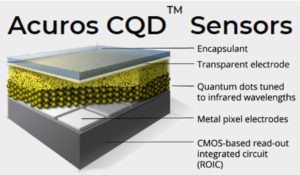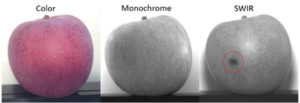
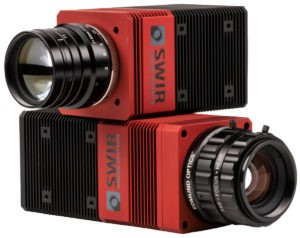
SWIR refers to the light wavelength range of 900nm to 2,500nm. SWIR light is similar to visible light, in that photons are reflected or absorbed by an object, providing the strong contrast needed for high resolution imaging. Much like visible light cameras, SWIR cameras deliver high resolution images at high frame rates.
SWIR imaging is especially good at imaging through silicon (which appears nearly transparent), checking liquid fill levels in opaque plastic containers with labels, verifying liquid coatings coverage on webs, determining whether clear adhesive has been applied, and viewing the contents of opaque plastic product packaging. SWIR is also used to differentiate between black plastics in recycling operations.
The following examples highlight some of the application spaces that can be addressed:
Silicon Wafers
In silicon wafer inspection, SWIR cameras can see through the wafer. Backside illumination enables alignment mark inspection for bonded wafer pairs and viewing the alignment of bumps between the two bonded wafers. Frontside SWIR illumination can be used to detect micro-cracks and voids that can’t be seen in visible light images.

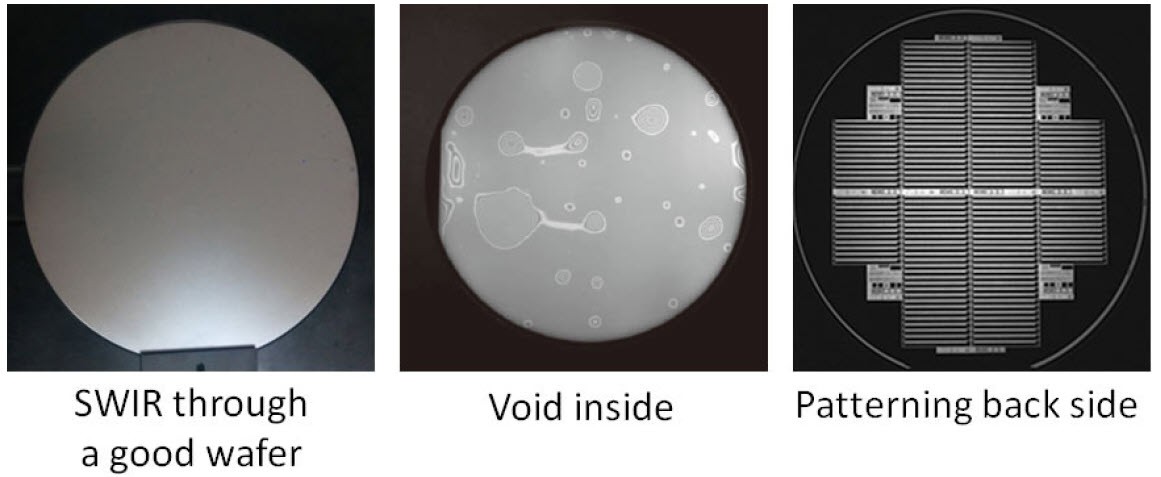
Opaque Paper & Plastic Packaging
The contents or features within opaque paper and plastic packaging become visible and inspectable when backlit with SWIR lighting.
In the following example, the printed opaque plastic bag is backlit at 1450nm and the bag edge, the zipper, and the vacuum seal areas are visible without interference from the printing on the bag. The bag may then be inspected to ensure none of the contents is stuck in the zipper or in the vacuum seal area, which may lead to leaking or spoilage.
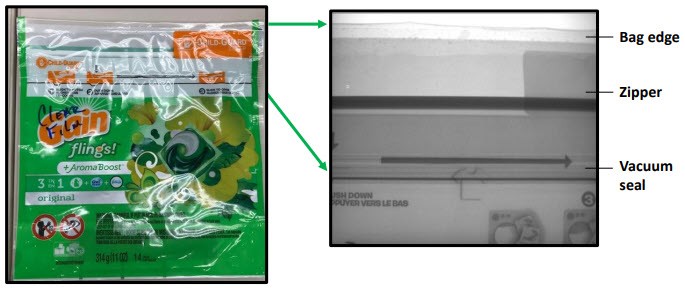
In the example below, the contents within plastic packaging become visible because the SWIR back and front lighting pass through the printed packaging. This is ideal for food packaging to verify the contents are correctly packaged or are present at all.
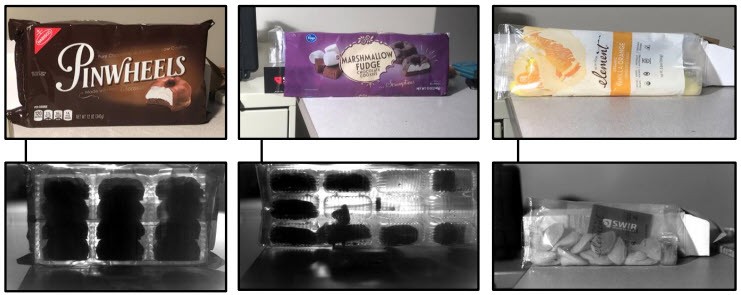
Liquid Levels & Liquid or Adhesive Presence
Liquids typically absorb SWIR wavelengths and often appear dark, enabling fill-level verification behind plastic labels or within tinted or opaque plastic vials and bottles.
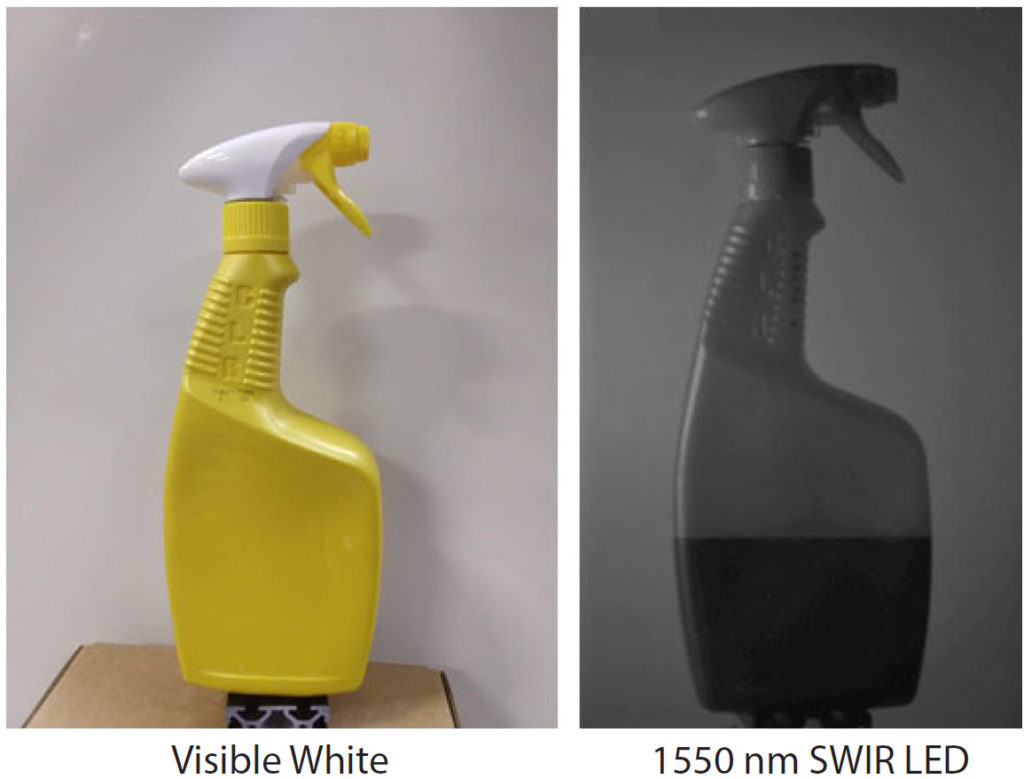
Since liquids and adhesives absorb SWIR wavelengths at varying degrees, based on their chemical composition, additional applications requiring the detection or differentiation of clear liquids or contamination, liquid coating coverage, and clear adhesive presence on surfaces can be addressed.
Produce and Moisture Content Inspection
Water is visible at 1,450nm and other SWIR wavelengths, making it appear dark in the acquired image. In produce sorting, bruises, as shown below, appear as dark spots based on the increase in water volume at that location. This capability can also be used in determining whether the item is dry and ready for further processing, such as for grain moisture content, dyed textile moisture, processed particle board moisture content, and for seal/packaging inspection for high-moisture goods.

SWIR Vision Systems Cameras Provide:
- Acuros™ CQD™ 640 Camera – 640 x 512 pixels at 380fps
- Acuros™ CQD™ 1280 Camera – 1280 x 1024 pixels at 90fps
- Acuros™ CQD™ 1920 Camera – 1920 x 1080 pixels at 60fps
- Full Visible-to-SWIR bandwidth, 400-1,700nm response, with eSWIR models in development for 2,100nm response
- Global shutter
- TEC cooling for low noise
- Pixel non-uniformity correction
- USB3 Vision and GigE Vision interfaces
- Compatible with range of SWIR lenses, with C, F, and M42 lens mounts
- Software GUI for camera control
- SDK included for user development
- Unlike many InGaAs cameras, Acuros™ CQD™ cameras are non-ITAR and are designated as EAR-99, with no export license required
SWIR Lenses
Although standard visible wavelength glass lenses can be deployed with SWIR cameras, SWIR-specific lenses include optical coatings that enhance the lens capabilities and image quality within the SWIR range.
Standard factory automation lenses for SWIR imaging are available in a range of focal lengths from our optics partners at Goyo, Navitar, Opto Engineering, SWIR Vision Systems, and others.
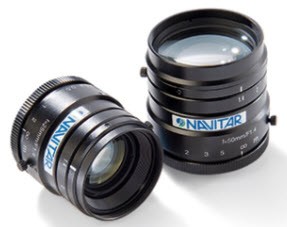
High Magnification SWIR Lenses
Applications in the semiconductor industry, such as bonded wafer target imaging, require the use of high magnification optics. Navitar’s Resolv4K modular high magnification lens system is available with special SWIR coatings to permit its use with SWIR Vision Systems cameras. The wafer images shown herein were made with the Navitar Resolv4K lens system with the SWIR coating.
To get even higher magnification out of the Resolv4K, SWIR-capable microscope objectives can be used with the Resolv4K. Additional information on the Navitar Resolv4K high magnification lens system is available on our High Magnification Lens page.
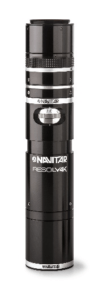
SWIR Lighting
SWIR lighting is available in a number of form factors and in specific SWIR wavelengths for back lighting or front lighting from Effilux and Smart Vision Lights.

Typical SWIR lighting wavelengths include 1,050, 1,200, 1,300, 1,450, and 1,550nm.
Please contact R.J. Wilson, Inc. to configure a complete SWIR imaging solution at 781-335-5500 or [email protected].

